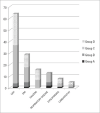Seroprevalence of SARS-CoV-2 IgM and IgG antibodies in an asymptomatic population in Sergipe, Brazil
- PMID: 33042199
- PMCID: PMC7541966
- DOI: 10.26633/RPSP.2020.108
Seroprevalence of SARS-CoV-2 IgM and IgG antibodies in an asymptomatic population in Sergipe, Brazil
Abstract
Objective: To estimate the prevalence of SARS-CoV-2 antibodies in an asymptomatic population in the state of Sergipe, Brazil. .
Methods: This cross-sectional study with stratified sampling (sex and age) included serological immunofluorescent tests for IgM and IgG on samples from 3 046 asymptomatic individuals. Sample collection was performed in wet-markets of the 10 most populous cities of Sergipe, Brazil. Exclusion criteria included symptomatic individuals and health workers. The presence of comorbidities was registered. .
Results: Of the 3 046 participants, 1 577 (51.8%) were female and 1 469 (48.2%) were male; the mean age was 39.76 (SD 16.83) years old. 2 921 tests were considered valid for IgM and 2 635 for IgG. Of the valid samples, 347 (11.9% [CI 10.7%-13.1%]) tested positive for IgM and 218 (8.3% [CI 7.2%-9.4%]) tested positive for IgG. Women over 40 had the highest prevalence for IgM (group C, p=0.006; group D p=0.04). The capital Aracaju displayed the highest prevalence for both antibodies; 83 (26.3% [CI 21.6%-31.6%]) tested positive for IgM and 35 (14.6% [CI 10.4%-19.7%]) for IgG. The most prevalent comorbidities were hypertension (64/123 individuals) and diabetes (29/123). .
Conclusions: A high prevalence of SARS-CoV-2 antibodies was found among asymptomatic persons in Sergipe. Women over 40 showed the highest rates. The capital, Aracaju, displayed the highest seroprevalence. Surveys like this one are important to understand how the virus spreads and to help authorities to plan measures to control it. Repeated serologic testing are required to track the progress of the epidemic.
Objetivo: estimar la prevalencia de anticuerpos dirigidos contra el SARS-CoV-2 en una población asintomática del estado de Sergipe, Brasil.
Métodos: estudio transversal con muestreo estratificado (por sexo y edad) que incluyó pruebas serológicas de inmunofluorescencia para IgM e IgG en muestras de 3 046 individuos asintomáticos. La recolección de muestras se realizó en los mercados húmedos de las 10 ciudades más pobladas de Sergipe, Brasil. Se excluyó a los individuos sintomáticos y a los trabajadores de la salud. Se registró la presencia de comorbilidades.
Resultados: De los 3 046 participantes, 1 577 (51,8%) eran mujeres y 1 469 (48,2%) varones; la edad promedio fue de 39,76 (SD 16,83) años. Se consideraron válidas 2 921 pruebas para la IgM y 2 635 para la IgG. De las muestras válidas, 347 (11,9% [CI 10,7%-13,1%]) resultaron positivas para IgM y 218 (8,3% [CI 7,2%-9,4%]) para IgG. Las mujeres mayores de 40 años tuvieron la mayor prevalencia de IgM (grupo C, p=0,006; grupo D, p=0,04). Aracaju, la capital del estado, mostró la mayor prevalencia para ambos anticuerpos; 83 (26,3% [CI 21,6%-31,6%]) resultaron positivas para IgM y 35 (14,6% [CI 10,4%-19,7%]) para IgG. Las comorbilidades más frecuentes fueron la hipertensión (64/123 individuos) y la diabetes (29/123).
Conclusiones: Se encontró una alta prevalencia de anticuerpos contra el SARS-CoV-2 en personas asintomáticas en Sergipe. Las mujeres mayores de 40 años mostraron las tasas más altas. La capital, Aracaju, mostró la mayor seroprevalencia. Las encuestas como esta son importantes para comprender cómo se propaga el virus y para ayudar a las autoridades a planificar medidas de control. Se requieren pruebas serológicas repetidas para dar seguimento al progreso de la epidemia.
Keywords: Asymptomatic infections; Brazil; asymptomatic infections; coronavirus infections; seroepidemiologic studies.
Figures
References
-
- The 2019-nCoV Outbreak Joint Field Epidemiology Investigation Team, Qun Li An Outbreak of NCIP (2019-nCoV) Infection in China [Wuhan, Hubei Province] China CDC Weekly. 2020;2(5):79–80. - PMC - PubMed
- 1. The 2019-nCoV Outbreak Joint Field Epidemiology Investigation Team, Qun Li. An Outbreak of NCIP (2019-nCoV) Infection in China [Wuhan, Hubei Province]. China CDC Weekly. 2020; 2(5): 79-80. - PMC - PubMed
-
- World Health Organization Statement on the second meeting of the International Health Regulations Emergency Committee regarding the outbreak of novel coronavirus (2019-nCoV) [Accessed 23 May 2020]. https://www.who.int/news-room/detail/23-01-2020-statement-on-the-meeting...)
- 2. World Health Organization. Statement on the second meeting of the International Health Regulations Emergency Committee regarding the outbreak of novel coronavirus (2019-nCoV) [Accessed 23 May 2020] https://www.who.int/news-room/detail/23-01-2020-statement-on-the-meeting...).
-
- The Worldometer COVID-19 CORONAVIRUS PANDEMIC. [Accessed 23 May 2020]. https://www.worldometers.info/coronavirus/?utm_campaign=homeAdvegas1?
- 3. The Worldometer. COVID-19 CORONAVIRUS PANDEMIC [Accessed 23 May 2020] https://www.worldometers.info/coronavirus/?utm_campaign=homeAdvegas1?
-
- Chan JFW, Yuan S, Kok KH, To KKW, Chu H, Yang J, et al. A familial cluster of pneumonia associated with the 2019 novel coronavirus indicating person-to-person transmission: a study of a family cluster. Lancet. 2020;395:514–523. - PMC - PubMed
- 4. Chan JFW, Yuan S, Kok KH, To KKW, Chu H, Yang J, et al. A familial cluster of pneumonia associated with the 2019 novel coronavirus indicating person-to-person transmission: a study of a family cluster. Lancet. 2020;395:514-23. - PMC - PubMed
-
- Li Q. 'Guan X, Wu P, Wang X, Zhou L, Tong Y, et al. Early Transmission Dynamics in Wuhan, China, of Novel Coronavirus-Infected Pneumonia. N Engl J Med. 2020;382:1199–1207. - PMC - PubMed
- 5. Li Q, Guan X, Wu P, Wang X, Zhou L, Tong Y, et al. Early Transmission Dynamics in Wuhan, China, of Novel Coronavirus-Infected Pneumonia. N Engl J Med. 2020;382:1199-207. - PMC - PubMed
LinkOut - more resources
Full Text Sources
Miscellaneous

